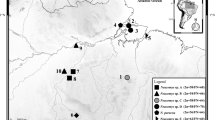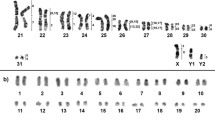Abstract
Cross-species chromosome painting was used to determine homologous chromosomal regions between two species of mole-rat, the naked mole-rat, Heterocephalus glaber (2n = 60), and the giant mole-rat, Cryptomys mechowi (2n = 40), using flow-sorted painting probes representative of all but two of the H. glaber chromosomal complement. In total 43 homologous regions were identified in the C. mechowi genome. Eight H. glaber chromosomes are retained in toto in C. mechowi, and 13 produce two or more signals in this species. The most striking difference in the karyotypes of the two taxa concerns their sex chromosomes. The H. glaber painting probes identified a complex series of translocations that involved the fractionation of four autosomes and the subsequent translocation of segments to the sex chromosomes and to autosomal partners in the C. mechowi genome. An intercalary heterochromatic block (IHB) was detected in sex chromosomes of C. mechowi at the boundary with the translocated autosomal segment. We discuss the likely sequence of evolutionary events that has led to the contemporary composition of the C. mechowi sex chromosomes, and consider these in the light of prevailing views on the genesis of sex chromosomes in mammals.
Similar content being viewed by others
References
Ashley T (2002) X-Autosome translocations, meiotic synapsis, chromosome evolution and speciation. Cytogenet Genome Res 96: 33–39.
Bailey J, Carrel L, Chakravarti A, Eichler E (2000) Molecular evidence for a relationship between LINE-1 elements and X chromosome inactivation: the Lyon repeat hypothesis. Proc Natl Acad Sci USA 97: 6634–6639.
Baker RJ, Bickham JW (1980) Karyotypic evolution in bats: evidence of extensive and conservative chromosomal evolution in closely related taxa. Syst Zool 29: 239–253.
Bennett NC, Faulkes CG (2000). African Mole-Rats: Ecology and Eusociality. Cambridge: Cambridge University Press.
Boyle AL, Ballard SG, Ward DC (1990) Differential distribution of long and short interspersed element sequences in the mouse genome: chromosome karyotyping by fluorescence in situ hybridization. Proc Natl Acad Sci USA 87: 7757–7761.
Burda H (2001). Determinants of the distribution and radiation of African mole-rats (Bathyergidae, Rodentia). Ecology or geography? Proceedings of the 8th International Symposium on African Small Mammals, Paris, July 1999. Paris: IRD Editions.
Casavant NC, Scott L, Cantrell MA et al. (2000) The end of the LINE?: lack of recent L1 activity in a group of South American rodents. Genetics 154: 1809–1817.
Dobigny G (2002). Speciation chromosomique chez les especes ouest-africaines de Taterillus (Rodentia, Gerbillinae): implication systematiques et biogeographiques, hypotheses genomiques. Paris: Museum National d'Histoire Naturelle.
Dobigny G, Aniskin V, Volobouev V (2002) Explosive chromosome evolution and speciation in the gerbil genus Taterillus (Rodentia, Gerbillinae): a case of two new cryptic species. Cytogenet Genome Res 96: 117–124.
Dobigny G, Ozouf-Costaz C, Bonillo C (2004a) Viability of X-autosome translocations in mammals: an epigenomic hypothesis from a rodent case-study. Chromosoma 113: 34–41.
Dobigny G, Ozouf-Costaz C, Waters PD et al. (2004b) LINE-1 amplification accompanies explosive genome repatterning in rodents. Chromosome Res 12: 787–793.
Ellerman JR, Hayman RW, Holt GWC (1940) The Families and Genera of Living Rodents. London: Trustees of the British Museum (National History), pp. 79–95.
Faulkes CG, Bennett NC, Bruford MW et al. (1997) Ecological constraints drive social evolution in the African mole-rats. Proc R Soc Lond B Biol Sci 264: 1619–1627.
Faulkes CG, Verheyen E, Verheyen W, Jarvis JUM, Bennett NC (2004) Phylogeographical patterns of genetic divergence and speciation in African mole-rats. Mol Ecol 13: 613–629.
Ferguson-Smith MA, Yang F, O’Brien PCM (1998) Comparative mapping using chromosome sorting and painting. ILAR J 39: 68–76.
Fredga K (1972) Comparative chromosome studies in mongooses (Carnivora, Voverridae). I. Idiograms of 12 species and karyotype evolution in Herpestinae. Hereditas 71: 1–74.
Gartler SM, Riggs AD (1983) Mammalian X-chromosome inactivation. Annu Rev Genet 17: 155–190.
Graves JAM (1995) The origin and function of the mammalian Y chromosome and Y-borne genes: an evolving understanding. Bioessays 17: 311–320.
Graves JAM, Foster JW (1994) Evolution of mammalian sex chromosomes and sex-determining genes. Int Rev Cytol 154.
Graves JAM, Watson JM (1991) Mammalian sex chromosomes: evolution of organization and function. Chromosoma 101: 63–68.
Honeycutt RL, Allard MW, Edwards SV (1991) Systematics and evolution of the family Bathyergidae. In: Sherman JUMJ, Sherman RDAPW, eds, The Biology of the Naked Mole-Rat. Princeton, NJ: Princeton University Press, pp. 45–65.
Ingram CM, Burda H, Honeycutt RL (2004) Molecular phylogenetics and taxonomy of the African mole-rats, genus Cryptomys and the new genus Coetomys Gray, 1864. Mol Phylogenet Evol 31: 997–1014.
Kawalika M, Burda H, Bruggert D (2001) Was Zambia a cradle of the genus Cryptomys (Bathyergidae, Rodentia)? African Small Mammals. Paris: IRD Editions, pp. 253–261.
Korenberg JR, Rykowsky MC (1988) Human genome organization: Alu, Lines, and the molecular structure of metaphase chromosome bands. Cell 53: 391–400.
Lee MR, Elder FFB (1980) Yeast stimulation of bone marrow mitosis for cytogenetic investigations. Cytogenet Cell Genet 26: 36–40.
Lyon MF (1961) Gene action in the X-chromosome of the mouse (Mus musculus L). Nature 190: 372–373.
Lyon MF (1998) X-Chromosome inactivation: a repat hypothesis. Cytogenet Cell Genet 80: 133–137.
Macholan M, Burda H, Zima J, Misek I, Kawalika M (1993) Karyotype of the giant mole-rat, Cryptomys mechowi (Rodentia, Bathyergidae). Cytogenet Cell Genet 64: 261–263.
Ohno S (1967) Sex Chromosomes and Sex Linked Genes. New York: Springer, 1967.
Ohno S, Kaplan WD, Kinosita R (1959) Formation of the sex chromatin by a single X-chromosome in liver cells of Rattus norvegicus. Exp Cell Res 18: 415–418.
Pack SD, Borodin PM, Serov OL, Searle JB (1993) The X-autosome translocation in the common shrew (Sorex araneus L.): late replication in female somatic cells and pairing in male meiosis. Chromosoma 102: 355–360.
Parish DA, Vise P, Wichman HA, Bull JJ, Baker RJ (2002) Distribution of LINEs and other repetitive elements in the karyotype of the bar Carollia: implications for X-chromosome inactivation. Cytogenet Genome Res 96: 191–197.
Priest JH, Heady JE, Priest RE (1967) Delayed onset of replication of human X chromosomes. J Cell Biol 35: 483–487.
Ratomponirina C, Viegas-Pequignot E, Dutrillaux B, Petter F, Rumpler Y (1986) Synaptonemal complexes in Gerbillidae: probable role of intercalated heterochromatin in gonosome–autosome translocations. Cytogenet Cell Genet 43: 161–167.
Ross MT, Grafham DV, Coffey AJ (2005) The DNA sequence of the human X chromosome. Nature 434: 325–337.
Russell LB, Bangham JW (1961) Variegated-type position effects in the mouse. Genetics 46: 509–525.
Takagi N (1974) Differentiation of the X chromosome in early female mouse embryos. Exp Cell Res 86: 127–135.
Telenius H, Pelmear AH, Tunnacliffe A et al. (1992) Cytogenetic analysis by chromosome painting using DOP-PCR amplified flow sorted chromosomes. Genes Chromosomes Cancer 4: 257–263.
Tucker PK (1986) Sex chromosome–autosome translocations in the leaf-nosed bats, family Phyllostomidae. I. Mitotic analyses of the subfamilies Stenodermatinae and Phyllostominae. Cytogenet Cell Genet 43: 19–27.
Van Daele PAAG, Dammann P, Meier JL et al. (2004) Chromosomal diversity in mole-rats of the genus Cryptomys (Rodentia: Bathyergidae) from the Zambezian region: with descriptions of new karyotypes. J Zool Lond 264: 317–326.
Vassart M, Seguela A, Hayes H (1995) Chromosomal evolution in gazelles. J Hered 86: 158–167.
Veyrunes F, Catalan J, Sicard B et al. (2004) Autosome and sex chromosome diversity among the African pygmy mice, subgenus Nannomys (Murinae; Mus). Chromosome Res 12: 369–382.
Viegas-Pequignot E, Benazzou T, Dutrillaux B, Petter F (1982) Complex evolution of sex chromosomes in Gerbillidae (Rodentia). Cytogenet Cell Genet 34: 158–167.
Waters PD, Dobigny G, Pardini AT, Robinson TJ (2004) LINE-1 distribution in Afrotheria and Xenarthra: implications for understanding the evolution of LINE-1 in eutherian genomes. Chromosoma 113: 137–144.
Yang F, Carter NP, Shi L, Ferguson-Smith MA (1995) A comparative study of karyotypes of muntjacs by chromosome painting. Chromosoma 103: 642–652.
Yang F, Muller S, Just R, Ferguson-Smith MA (1997a) Comparative chromosome painting in mammals: human and the Indian muntjac (Muntiacus muntjak vaginalis). Genomics 39: 396–401.
Yang F, O’Brien PCM, Wienberg J, Ferguson-Smith MA (1997b) A reappraisal of the tandem fusion theory of karyotype evolution in the Indian muntjac using chromosome painting. Chromosome Res 5: 109–117.
Author information
Authors and Affiliations
Corresponding author
Rights and permissions
About this article
Cite this article
Deuve, J.L., Bennett, N.C., O’Brien, P.C.M. et al. Complex evolution of X and Y autosomal translocations in the giant mole-rat, Cryptomys mechowi (Bathyergidae). Chromosome Res 14, 681–691 (2006). https://doi.org/10.1007/s10577-006-1080-3
Received:
Revised:
Accepted:
Published:
Issue Date:
DOI: https://doi.org/10.1007/s10577-006-1080-3




